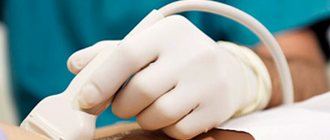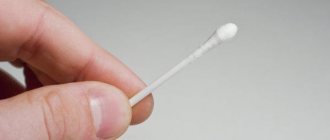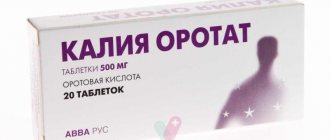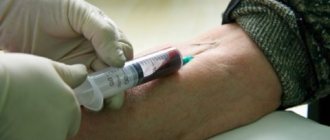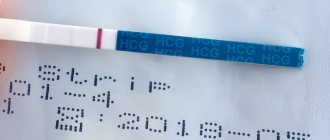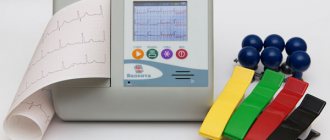How to measure temperature correctly with a thermometer under your arm
It is important to check the technical condition of the device you are using - replace the battery in the digital thermometer if necessary, adjust the infrared thermometer, and make sure the mercury thermometer is intact. If you have doubts about the reliability of the results obtained - for example, the child’s forehead is hot, but the device shows a normal temperature, repeat the procedure or measure the indicator on another part of the body
Mercury thermometer
Before using a mercury thermometer, shake it to bring down the mercury column to the minimum value on the scale, less than 35 °C. The device must be dry and clean; if you measure orally or rectally, a prerequisite for using the thermometer is its preliminary disinfection. For glass thermometers, to avoid damage, there are rules for careful storage in a case.
When performing the procedure in the armpit, the device is kept in a state of balance, pressed tightly to the body for the required time. For oral measurement, the device is placed under the tongue, it closes tightly, and breathing is done through the nose. During the rectal method of measurement, the patient is placed in a lying position on his side, the thermometer is inserted through the sphincter into the rectum and held for two to three minutes.
Time to measure body temperature with a mercury thermometer
When using contact thermometers, the type of which is mercury, the time during which the measurement is carried out is important. Depending on the measurement location, it is:
- 5-10 minutes - for the axillary method;
- 2-3 minutes - for rectal;
- 3-5 minutes - for oral.
Electric thermometer
Digital measuring instruments must be used when you want accurate and fast results. The sound signal function, which is equipped with electric thermometers, makes it easier to monitor the temperature measurement, since it notifies the user when the measurement process is completed. They produce so-called instant thermometers, which, thanks to the high sensitivity of the thermoelement, give results in 2-3 seconds.
Measuring temperature readings from a distance is a convenient feature of infrared thermometers. These devices are the result of high-tech laboratory developments, which determines the quality of their work and the accuracy of the data obtained. They do not have a harmful effect on the body, and are suitable for both immobile patients and infants who are in constant motion.
Where to take the temperature
Not all parts of the body have the same indicator; therefore, there are different ways to measure temperature. To obtain an accurate determination of the state of the body, this biometric indicator is determined:
- axillary (the thermometer is installed and held with the working end in the armpit);
- orally (measurement is carried out by taking the level of thermal radiation in the mouth);
- rectally (in the rectum);
- in the inguinal folds;
- in a woman's vagina.
Measurement methods
There are several ways to measure temperature.
Grandmother's method. Surely, you remember how in childhood your mother or grandmother touched her forehead or temple with her lips to determine the presence of temperature. It’s difficult to call this a method of measurement; rather, identifying presence, because thus it is impossible to know the exact temperature. Nevertheless, many mothers use this method for the initial determination. If your child's forehead is warmer than your lips, then most likely there is an increase in temperature.
Determination by external signs. This method also does not provide accurate data, but only helps to identify the presence of elevated temperature. At temperature, external signs appear:
- sweating;
- redness of the face, particularly the cheeks;
- rapid breathing;
- rapid pulse;
- hot palms, bends of elbows and knees, heels;
- chills;
- dry lips and tongue.
Using a thermometer. To obtain accurate data on the current temperature, you must use a thermometer, also known as a thermometer. Using a thermometer it is possible to measure temperature in four zones
It is important to remember that each zone has its own temperature norm, which may differ from generally accepted 36.6
- Measurement in the armpit. The norm is 36-37 degrees.
- Measurement in the oral cavity. The norm is 36.6-37.2 degrees.
- Measurement in the rectum. The norm is 36.9-37.4 degrees.
- Measurement in the ear canal. The norm is 36-37 degrees.
Some children have an individual normal body temperature. In this regard, it is recommended to establish what indicators are normal for your child in a normal, calm, healthy state.
Measuring body temperature and recording the measurement data on a temperature sheet.
MEASURING BODY TEMPERATURE
If it is necessary to quickly identify patients with a high temperature in a large group (most often in children), an instant thermometer “Thermotest” is currently used - a polymer plate coated with a liquid crystal emulsion. To measure the temperature, a plate is placed on the forehead: at a temperature of 36-37 ° C, the letter “N” (Norma) lights up on the plate, and at a temperature above 37 ° C, the letter “F” (Febris - fever) lights up. The height of the temperature rise is determined with a medical thermometer.
Patients' body temperature is measured, as a rule, 2 times a day: in the morning on an empty stomach (from 7 to 9 o'clock) and in the evening, before the last meal (from 17 to 19 o'clock). Measuring body temperature after eating is not recommended.
Most often, the thermometer is placed in the axillary area (if malingering is suspected, in both at the same time), and sometimes in the groin area for children.
Sequence of actions when measuring temperature:
I. Preparation for manipulation
Rice. 1. Measuring body temperature in the armpit.
1) prepare a thermometer, watch, pen, temperature sheet;
2) explain to the patient how he should behave during thermometry;
3) shake the thermometer (Fig. 1, a);
4) make sure that the mercury has dropped into the tank to the lowest level on the scale, i.e. below 35°C (Fig. 1, b);
II. Performing a manipulation
5) wipe the patient’s axillary area dry (wet skin distorts the thermometer readings) (Fig. 1, c);
6) examine the axillary area: in the presence of hyperemia, local inflammatory processes, temperature cannot be measured (the thermometer readings will be higher than the temperature of the whole body);
7) place the thermometer reservoir in the armpit so that it is in full contact with the skin (the patient must press his shoulder to the chest) (Fig. 1, d);
 after 10 minutes, remove the thermometer and determine its readings;
after 10 minutes, remove the thermometer and determine its readings;
III. End of manipulation
Rice. 2. Individual temperature sheet.
9) write down the thermometer readings on the general (guard) and individual temperature sheets (Fig. 2);
10) shake the thermometer (the mercury column should fall into the reservoir) and immerse it in the disinfectant solution (Fig. 3, a), then rinse under running water, wipe dry and put it in the reservoir (Fig. 3, b).
Fig.3. Processing of thermometers after use a) and their storage.
It is relatively rare to measure temperature in the oral cavity or rectum. In the first case, the reservoir of a special medical thermometer is placed under the tongue, and the patient holds the body of the thermometer with his lips. When measuring the temperature in the rectum, the thermometer reservoir is lubricated with Vaseline and inserted into the anus behind the internal sphincter, then the buttocks are brought together to fix the thermometer.
Installation of mustard plasters.
MUSTARD PLASTERS
Sequence of actions when installing mustard plasters:
I. Preparation for the procedure
1) explain to the patient the essence of the procedure:
2) check the suitability of mustard plasters: mustard should not fall off the paper, its specific smell should remain;
Rice. 2. Installation and removal of mustard plasters.
3) pour hot (40-45° C) water into the tray (at higher temperatures, essential mustard oil is destroyed);
4) place the patient in a comfortable position;
II. Executing the procedure
5) alternately immerse the mustard plasters for 5-10 seconds in hot water, apply them tightly to the skin with the side covered with mustard powder (Fig. 2, a, b);
6) cover the patient with a towel and then a blanket: after a few minutes the patient feels warmth and a slight burning sensation (Fig. 2, c);
III. End of the procedure
7) after 5-15 minutes, remove the mustard plasters (the skin should be hyperemic);
 wipe the skin with a napkin soaked in warm water, and then dry with a towel and cover the patient warmly again (Fig. 2, d).
wipe the skin with a napkin soaked in warm water, and then dry with a towel and cover the patient warmly again (Fig. 2, d).
Remember! With longer exposure to mustard plasters, a chemical burn of the skin with the formation of blisters is possible.
Setting up cans.
Due to the vacuum created in it, the medical jar is suctioned to the skin, in which, as in deeper organs, blood and lymph circulation is enhanced, tissue nutrition is improved, as a result of which inflammatory foci resolve faster.
3 remember! Cupping should not be used in cases of pulmonary hemorrhage, pulmonary tuberculosis, malignant neoplasms, skin diseases, general exhaustion, patient agitation, or high body temperature.
In (Fig. 1, a), black dots indicate areas where cans can be placed, and shading indicates where cans cannot be placed.
| Rice. 1. Installing and removing cans. a - areas where cans can and cannot be placed; b - equipment for placing cans; c – e – placement of cans; s - h - removal of cans. |
Sequence of actions when placing cans:
I. Preparation for the procedure
1) explain to the patient the essence of the procedure;
2) prepare a tray with everything you need (vaseline, spatula, ethyl alcohol 70°, cotton wool, forceps, matches, tray with jars) (Fig. 1 b);
3) place the patient in a comfortable position: when placing the cups on his back, he should lie on his stomach, head turned to the side, hands clasping the pillow;
4) free the required area of the body from clothing;
5) if the patient's skin is covered with hair, shave it off, then wash the skin with warm water and wipe dry;
6) if the patient has long hair, cover it with a towel so that it does not accidentally ignite;
7) apply a thin layer of Vaseline to the skin with your hand (Fig. 1, c);
 make a wick from cotton wool using a forceps;
make a wick from cotton wool using a forceps;
II. Executing the procedure
9) moisten the wick with alcohol, squeeze out excess alcohol, close the bottle with alcohol and set it aside;
10) light the wick, take 1-2 cans in your left hand (if you are right-handed), then quickly move for 0.5-1 sec. bring a burning wick into the jar (the jar should be kept close to the surface of the body), with an energetic movement, apply the jar with its entire thickened edge to the skin (Fig. 1, d); the flame creates a vacuum of air in the jar, the skin is drawn into it and then acquires a bright red or crimson color (place all the jars in this way);
Remember! The flame should only displace the air from the can, but not heat its edges, as in this case, skin burns are possible.
11) cover the patient with a towel, blanket and leave him lying down for 10-15 minutes (Fig. 1, e);
12) remove the jars one by one: slightly tilt the jar to the side, and press the skin at the edge of the jar with the finger of your other hand. At the same time, air penetrates into the jar, and it is easily separated from the skin (rns.1, e);
13) dry the skin with cotton wool, help the patient get dressed quickly, then cover him; after the procedure, the patient should lie down for another 20-30 minutes (Fig. 1, g, h);
14) wipe the jars and place them in the tray.
Setting up leeches.
Medical leeches are used for medicinal purposes as a blood extractor and local anticoagulant. Treatment with leeches is called “hirudotherapy”.
The secretion of the salivary glands of leeches contains hirudin, a substance that has the ability to inhibit blood clotting and prevent the development of thrombosis.
A hungry leech can suck 10 ml of blood. Once saturated, the leech disappears, but bleeding from the wound continues for 6 hours - 1 day. Thus, 8-10 leeches can cause blood loss of up to 300-400 ml.
If leeches are placed for the purpose of administering hirudin, the duration of the procedure is 15 minutes; bleeding takes 45-60 minutes.
Only hungry leeches are used for medicinal purposes: for this purpose they must swim in the aquarium for 2-3 months.
In Fig. 4, a, shows the places where leeches can be placed.
Sequence of actions when placing and removing leeches
I. Preparation for the procedure
1) explain to the patient the essence of hirudotherapy;
2) reassure the patient if he is afraid of the upcoming procedure;
3) prepare everything for the various stages of the procedure (Fig. 4, b)
| Rice. 4. Placement of leeches | Rice. 5. Removing leeches. |
a) skin treatment: sterile beads, warm boiled water, sterile 40% glucose solution;
b) placing leeches: 8-10 leeches in a separate container, several medical jars, sterile napkins, tweezers, watches;
c) removing leeches: gloves, a container with a disinfectant solution, ammonia, cotton wool, sterile wipes, bandage, adhesive plaster, scissors;
4) place the patient in a position that is comfortable for him and necessary for the procedure;
II. Executing the procedure
5) treat the area of skin on which leeches are to be placed and the skin around it with sterile balls moistened with warm boiled water (this causes a rush of blood to the skin);
6) moisten the prepared area of skin with a sterile solution
glucose (leeches are more likely to stick);
7) place one leech in a medical jar, use tweezers for this purpose (Fig. 4, c);
Remember! Leeches should not be placed over blood vessels: this can cause severe bleeding! When placing leeches on the mastoid processes, you need to step back 1 cm from the auricle; When placing leeches on the lower leg, they should be placed along the vein in a checkerboard pattern, retreating 1 cm from the vein on both sides.
 bring the jar to the skin, turn it upside down and press it against the skin: the leech, once in a confined space, will bite through the skin within 1-2 minutes (Fig. 4, d);
bring the jar to the skin, turn it upside down and press it against the skin: the leech, once in a confined space, will bite through the skin within 1-2 minutes (Fig. 4, d);
9) remove the jar as soon as you see that the leech has bitten the skin and wave-like movements appear in its front part;
10) place a sterile napkin under the rear sucker, since attaching the leech to the skin with the rear sucker significantly reduces sucking activity;
11) place the remaining leeches in the same way;
12) observe the activity of the leech: if the leech does not move, lightly run your finger along its surface - this should cause a wave-like movement of the leech. If it is still not there, the leech must be removed by running a ball moistened with ammonia over its surface;
III. End of the procedure
13) prepare everything necessary to remove leeches, put on gloves (Fig. 5, a);
14) remove the leeches if they were placed for 15 minutes in the manner described in paragraph 12 (if the leeches were placed for 45-60 minutes, they will fall off on their own as soon as they are saturated with blood);
15) place the leeches in a disinfectant solution (exposure will depend on the type and concentration of the solution) (Fig. 5. b);
16) place sterile napkins on the bite sites (Fig. 5.c);
17) place a sufficient layer of cotton wool on top of the napkins (profuse bleeding is possible!);
18) secure the napkin and cotton wool with a bandage or adhesive plaster (if a bandage is not possible) (Fig. 5. d);
19) remove everything unnecessary;
20) throw the leeches into the sewer at the end of the exposure;
21) remove gloves.
Remember! You cannot change the bandage during the day. If it is soaked in blood, you need to bandage cotton wool over the bandage. You can remove the bandage only after a day. If the bleeding has stopped, you should treat the skin and wounds with sterile balls moistened with a 3% solution of hydrogen peroxide, and apply a dry aseptic bandage for 2-3 days. If bleeding continues, it is stopped by applying a sterile ball moistened with a strong solution of potassium permanganate (potassium permanganate) or a pressure bandage to the wound.
Previous4Next
Measurement algorithm
Using the correct algorithm for measuring body temperature, you will reduce the influence of external factors, you will be able to timely monitor changes in temperature indicators, thereby speeding up the patient’s recovery process. With any method and use of any type of contact thermometer, follow the rules of hygiene and disinfection of the devices themselves. Algorithm for using a mercury thermometer:
Wash your hands thoroughly. Remove the device from the case. Shake it gently but forcefully, keeping your index finger on the reservoir. Make sure the mercury drops below 35°C. Take a measurement. Disinfect the thermometer after completing the procedure. Record your findings.
Measuring body temperature in the armpit
By following the following algorithm, you will understand how to measure the temperature in the armpit with any thermometer in order to get an accurate value and not use another method:
- take measurements several times a day, at regular intervals;
- press the thermometer tightly to your body to avoid the thermometer being loose;
- keep your body still during the procedure;
- Record in writing the upper and lower indicators during the day.
Which armpit should you measure under?
The physical sensitivity of the right and left armpits is the same, so it does not matter which one you use to measure temperature readings. If you wish, you can take the value from both the right and left sides several times to make sure that you get the same data as a result. If you have doubts about the correctness of the result obtained, you can always measure the temperature in another sensitive area, in the groin area, for example.
The answer to the question of how to measure the temperature in the mouth correctly lies in the following two main points - the position of the thermometer and the time of measurement. Place the device under the tip of your tongue, press it firmly and close your mouth. To obtain data, hold this position for two to three minutes, breathe through your nose, evenly and calmly. Before carrying out the procedure, be sure to treat the thermometer with a disinfectant wipe.
Brief algorithm of actions
- If you prefer a mercury-based thermometer, then make sure that it displays the optimal start indicators.
- The electronic thermometer should be reset by pressing a special button.
- Before starting the procedure, you should carefully examine the area of the body in which the manipulation will be performed.
- The thermometer with a specially designated side is placed in the axillary area, pressing the equipment tightly against the body in order to obtain correct data. If another area is intended for measurement, then the thermometer must be disinfected. This will protect you from the appearance of unwanted infections in the body.
- After a few minutes, you should pull out the thermometer and familiarize yourself with the data. For electronic equipment, there is often a signal indicating the end of the measurement.
- After the measurement procedure, the thermometer should be treated with a specialized medical solution.
- Temperature measurements are carried out twice a day: in the morning and in the evening. If there is a clear increase, determine the frequency of measurements at intervals of two or three hours, as necessary.
It is important to know
- mercury thermometers should be stored in a special place that will be out of reach of children,
- in order to protect yourself and the child, do not leave him unattended during such a procedure,
- prevent independent contact between the child and the thermometer, because he can accidentally break it by dropping it on the floor,
- the measuring device should be stored in specially designated tubes,
- If a mercury-based thermometer breaks, immediately consult a medical professional regarding your course of action.
Other factors affecting body temperature
If a person is healthy, body temperature is also affected by:
- Time of day: morning is usually less than evening.
- Cloth.
- Ambient temperature, because by measuring the temperature under the armpit, we are actually measuring the surface temperature of the skin.
- Previous physical activity, eating, showering, bathing.
- Method of measurement: under the armpit the numbers are lower, orally and rectally - higher.
- Phase of the menstrual cycle in women. By measuring the temperature rectally every morning, you can determine the day of ovulation, when the temperature drops and then rises sharply. Based on this behavior of the temperature curve, the most favorable days for conception are determined.
MOST DANGEROUS
The most inexpensive of the thermometers remains the mercury one, but every year it becomes more and more difficult to buy one. And soon it will completely disappear from sale - from 2020 Russia will completely abandon the use of mercury, which is provided for by the so-called Minamata Convention.
Mercury is a very dangerous substance because when it enters the body it affects the central nervous system. The most toxic vapor is mercury, which begins to evaporate at room temperature. Moreover, each old thermometer contains two grams of this heavy metal.
Mercury thermometers require careful handling - if broken, there is a serious risk of poisoning. If an emergency does occur, you need to know the basic rules for collecting mercury.
“The first step is to isolate the room in which the thermometer was broken. After this, you need to open the windows for ventilation, since mercury vapor is primarily dangerous for humans,” says Igor Shalaev, deputy head of the department of engineering and technical measures, radiation, chemical, biological and medical protection of the Ministry of Emergency Situations.
Before cleaning, you must protect yourself with a minimum set of protective clothing - gloves and a respirator.
The main thing is to prevent the spread of mercury throughout the living space, so it is extremely important to cover pets, which can become carriers of tiny droplets, the expert says
According to him, after completing the procedure, you can, to be sure, walk over the surfaces with tape or adhesive tape; mercury sticks well to such materials, and in this way it is easy to get rid of microscopic droplets.
“After completing the collection, you need to treat the surface with active cleaning substances; if you have potassium permanganate in your first aid kit, you can use this solution,” continues the rescuer. “We must remember that a jar of mercury and all objects in contact with it cannot be thrown away; it must be handed over to an organization that deals with the disposal of hazardous substances.”
At the same time, the interlocutor reminds that if a person doubts whether he was able to collect all the mercury (for example, fragments of a broken thermometer scattered throughout the room), you can call specialists from the Ministry of Emergency Situations, who will measure the concentration of vapors of this metal in the air and carry out demercurization.
Temperature measuring instruments
In thermometry, a special measuring device is used - a thermometer to measure body temperature. These devices are also called thermometers. They are made from different materials (glass, plastic), have their own specifics and operating principle (contact, non-contact; digital, mercury, infrared), and measurement error. Each type of these devices has its own advantages and disadvantages.
Classification of devices
The main principle by which thermometers for measuring body temperature are classified is the principle of operation of these measuring instruments. According to it they are divided into:
- mercury;
- digital;
- infrared (for non-contact measurement method).
Mercury thermometers are made of glass and work on the principle of expansion of mercury contained in their glass reservoir. When heated from the body, the mercury column moves up the scale, reaching a mark corresponding to the t temperature of the body. This method of determining temperature characteristics helps to obtain high accuracy of measurement results; the error in actual temperature when using this type of thermometer is only 0.1 degrees.
- fragility of the body;
- mercury toxicity (there is a danger of poisoning if you accidentally damage a mercury tank or break a thermometer);
- measurement duration (up to 10 minutes).
Digital, electronic thermometers are widely used. They can have a different appearance, their body is made of plastic, and the temperature is determined through the operation of a thermodynamic sensor. Electronic thermometers are safer than mercury thermometers and help to obtain quick measurement results (within one minute), however, the accuracy of the readings of these devices is significantly inferior to mercury thermometers.
Infrared devices for measuring temperature indicators do not require direct contact with the body; measuring the temperature value takes several seconds. A special sensor displays a digital infrared image; the device requires configuration, produces an error of about 0.2 degrees, is expensive, and is often used in cases where the patient cannot be disturbed.
Especially for infants who cannot remain at rest for a long time, nipple thermometers disguised as a regular pacifier have been invented. They are made from silicone, the measurement duration is about five minutes, but this does not bring any inconvenience to the child. The deviation from the exact data can reach 0.3 degrees.
How is temperature measured?
The SI system (International System of Units) uses two basic units for measuring temperature indicators: degrees Celsius and degrees Kelvin. In medicine, body temperature is measured on the Celsius scale, on which zero is the freezing temperature of water, and one hundred degrees is the boiling point of water.
- Treatment with drugs of the pancreas for symptoms of diseases
- Cake creams: recipes with photos
- How to quickly straighten your hair without ironing
Classification of medical thermometers
Human senses cannot determine temperature with the necessary accuracy. For this purpose, special devices have been created that contain substances or materials that are sensitive to heating or cooling. It is by their reaction or state that one or another temperature value of the environment is judged.
The following types of thermometers are most often used in domestic conditions:
- mercury;
- electronic;
- infrared;
- thermal strips.
Each of them deserves a separate description. You can figure out which thermometer shows temperature more accurately - mercury or electronic - by comparing their design and technical characteristics. They depend on the measurement method and the build quality of the device.
Mercury thermometer
The action of a mercury thermometer is based on the property of a liquid to change its volume depending on temperature. Its main working element is a sealed glass container partially filled with mercury. One end of it is made in the form of a thin capillary, along which, when heated, the boundary of the liquid metal moves.
Only the edge of the flask containing the bulk of the mercury comes into direct contact with the body. To reduce the influence of the environment on the quality of measurements, the capillary is placed in a tube with a vacuum.
Mercury thermometer gives accurate readings
The scale located next to the capillary shows the temperature quite accurately. For ease of observation, mirror strips are inserted into the thermometer, visually increasing the thickness of the mercury column. A special feature of medical thermometers is the local narrowing of the glass tube, which prevents the liquid from returning to the main container during cooling. This allows you to determine the maximum reached, but requires shaking the device after use.
Important! Mercury thermometers have a fragile structure and require careful handling. You need to be especially careful when measuring temperature in children
Digital Thermometer
An electronic thermometer is often styled as a mercury analogue. The difference between an electronic and mercury medical thermometer lies in the principle of operation. The digital device has a built-in temperature sensor, a power supply and a liquid crystal display on which the readings are displayed. Even a person with poor eyesight can easily see them.
Electronic thermometer suitable for people with low vision
Infrared thermometer
Infrared thermometers differ from typical electronic devices by the presence of a special sensor that measures the power of the heat flow emanating from the object being studied. This allows us to produce not only contact, but also non-contact models, which is especially convenient when working with a child. The measurement is very fast and the readings are shown digitally on the display.
Such a thermometer allows you to determine the temperature of any part of the human body or other objects of study.
Infrared thermometer measures temperature very quickly
Thermal strips
Thermal strips are small pieces of polymer film coated with crystals of a substance that changes color when a certain temperature is reached. They take up minimal space, are convenient on the road, give results within a few seconds, but are not highly accurate. They are often used as an aid.
Thermal strips are convenient on the go. Tip! By taking several thermal strips with you on a trip, you will be able to monitor your health in any situation.
Digital Thermometer
It works by changing the degree of resistance of the conductor under different temperature conditions: when the metal is heated, the resistance to current transmission increases. The temperature range depends on what metal is used as a conductor.
The leading metal is copper; in its range the minimum temperature is -50 °C, the maximum is +180 °C. Platinum thermometers indicate a range from -200 °C to +750 °C, but such thermometers are more expensive. An electronic thermometer with a remote sensor is now very popular in everyday life; it is most often used for baths - the temperature can be controlled externally.
Digital Thermometer
It doesn’t take long to wait for such a thermometer to measure your temperature. Which is very good for restless children. However, as you know, Russians do not trust electronic thermometers too much. It turns out that the whole point is that often they simply don’t know how to choose it.
Electronic thermometers begin to “fib” when their battery runs out, but this is more typical for older models. New thermometers have a special battery voltage indicator built in, which will show you in advance that the battery needs to be replaced.
It is also worth paying attention to what place the thermometer is intended to measure. As Vladimir Bolibok says, products that are certified in Russia are mainly intended for measuring in the armpit
Sometimes you come across batches that are supposed to measure the temperature in the mouth or anus.
We can confidently say that an electronic thermometer is universal for all families with children. However, you should not save when choosing it, as it will serve you for a long time.
Infrared thermometers
Price
: 2-7 thousand rubles
Infrared thermometers allow you to measure temperature without contact with a person or animal. This speeds up the process and reduces the risk of transmission of infection.
An infrared thermometer measures thermal radiation from the surface of the human body. The working distance of home models is 3-8 cm, thermometers for mass use (industrial pyrometers) “hit” further.
Typically the sensor is placed on the ear or forehead. The process is somewhat reminiscent of scanning barcodes at a supermarket checkout.
At airports, train stations and in transport, infrared thermometers are now used. The result is immediately visible on the LCD screen, so you can quickly identify potentially sick people in a stream of people.
Infrared thermometers can also measure the temperature of surfaces. Or, for example, hot tea or soup.
But the measurement accuracy will vary: from 0.1-0.4 degrees Celsius for human body temperature to 1-3 degrees for other measurements.
Infrared thermometers from well-known medical equipment manufacturers are more accurate than Chinese no-name ones. But gadget manufacturers are also entering the market: for example, Xiaomi with Mi Mijia iHealth.
pros
:
non-contact temperature can be measured without the patient's consent measures temperature in a wide range rarely fails temperature measurement takes 1-2 seconds many models are waterproof
Minuses
:
the battery will have to be changed regularly; the measurement accuracy is lower than that of mercury or alcohol thermometers; some models will have to be frequently calibrated; many cheap infrared thermometers do not provide the required accuracy. Read reviews before purchasing
Infrared thermometry
The operating principle of contactless devices is to simply touch the human skin. They are equipped with a display that shows the result in an instant.
A special feature of instant thermometers is that they do not contain mercury or glass; they are completely safe. They are used if a febrile child is sleeping or the patient is in an uncontrollable agitated state.
When applying this method, one should take into account the influence of environmental factors that can provoke fluctuations in indicators.
Non-contact infrared thermometer measures temperature without touching the child's body
FASTEST
Despite the higher price compared to traditional mercury thermometers, which starts from 350 rubles, and the need to change the battery from time to time, electronic thermometers are currently considered optimal in terms of safety and quality.
However, often the simple procedure of measuring temperature can become a problem - holding the thermometer under the armpit of a restless child for as long as 7-10 minutes becomes an impossible task for parents.
In this case, the most technologically advanced temperature measuring device available today will help - a non-contact infrared thermometer. Unlike an electronic thermometer, which takes measurements using a temperature sensor, a non-contact device reads infrared radiation from the human body.
Photo: Vladimir Saraev, Sibnet.ru | Buy illustration
“When using an infrared thermometer, there are some nuances,” says Olga Babich. “After turning it on for the first time, you need to let it run for about five minutes so that it “feels” the temperature of the room.”
According to her, if a person is sweating, it is necessary to dry off, as wet skin will lead to incorrect measurements. Moreover, the measurement itself, for which the forehead is usually used, lasts only two seconds, which makes such a device very convenient for small children.
“By the way, an infrared thermometer is convenient because it can measure not only body temperature - if necessary, it will show the temperature of the room or, say, wine,” continues the interlocutor.
The main disadvantage of non-contact thermometers is the high price, which averages 3 thousand rubles. Despite this, the demand for them is now the highest, since they are really very convenient, the expert says.
Photo: Vladimir Saraev, Sibnet.ru | Buy illustration
Oral method of determining temperature
Measuring body temperature in the mouth has been used more often than other methods in the last century. And now in some countries this method is widely used. It is quite reliable and simple to implement.
Algorithm of actions:
- disinfect the thermometer and bring its readings below 35 degrees;
- place the end of the thermometer under the tongue;
- Purse your lips tightly and breathe through your nose for 3-5 minutes;
- take readings and wipe the thermometer with alcohol.
Normal readings for oral measurement are 36.8-37.2 degrees Celsius.
This method is not suitable for hyperactive children and people with mental disorders, as they can bite through the thermometer, which can lead to cuts and intoxication.
Impaired nasal breathing is also a contraindication, since during the procedure you should not open your mouth slightly to breathe. This will significantly reduce the thermometer reading.
Features of the operation of mercury and digital thermometers
Both types of thermometers are quite easy to use, but have a number of features that influence each user’s opinion about whether an electronic or mercury thermometer is better. If we consider them together, we can find a number of significant differences.
Preparing for work
The mercury thermometer is always ready to start working. The maximum that needs to be done to start using it is to shake it to get rid of the old indication.
For a digital device, you will need to make sure that there is a battery and put it into operation by pressing a button or lever. To do this, you need to carefully read the instructions for use at least once.
Termination of work
At the end of the measurements, shake the mercury thermometer, wipe it with a disinfectant solution, place it in a reliable protective case and put it away from children.
In the case of an electronic device, all of the above actions except disinfection will be unnecessary. After some time, it goes into shutdown mode on its own. Some models have removable tips to help maintain hygiene requirements.
The mercury thermometer should be wiped with a cotton swab and alcohol.
Taking measurements
The mercury thermometer should be carefully placed in the area being examined for elevated temperature and wait 5-10 minutes.
Digital models have their own algorithm of actions. They are installed similarly to mercury devices. Typically they monitor the readings for a certain period of time and then sound an alarm. Manufacturers recommend taking readings after waiting a few more seconds.
Electronic thermometers notify with a sound signal
Which thermometer is more accurate, mercury or electronic, will not be decisive when purchasing a certified product. An error of 0.1 degrees Celsius is acceptable in medical research.
Use by children
Children can also be trusted to handle the digital thermometer, as it is absolutely safe. As a last resort, you will have to take a second measurement if the child’s behavior raises doubts about the correctness of the readings.
When using a mercury tube, it is better to follow the entire process yourself.
Disposal
The need for disposal of mercury thermometers usually arises when they are mechanically damaged. Such devices should not be thrown into a trash can or landfill to avoid contamination of the area with mercury vapor. For this purpose, there are specialized organizations that utilize heavy metals. If you find it difficult to find one in your city, seek advice from the nearest pharmacy or point of sale of mercury lamps.
The mercury thermometer must be recycled
Electronic thermometers break more often. But there are not so many problems with their elimination. The method of their disposal must be specified in the instructions supplied with the product.
Mercury thermometer
An old, well-known method of measuring temperature. Many people prefer it as a time-tested thermometer. It takes seven to ten minutes to measure the temperature with such a thermometer. And although it is believed that its indicators are the most accurate, using a mercury thermometer is not only unecological (after all, you can’t just throw away this thermometer), but also unsafe.
In addition, it is also not worth talking with confidence about impeccable accuracy. According to the expert, a thermometer is a measuring instrument that always has an error in one direction or another. You can even conduct an experiment - place several mercury thermometers in one container with warm water, and after a while check the readings. Most likely they will vary.
“For everyday situations, when you measure the temperature at home, the actual accuracy of the measurement is not particularly important: the thermometer can lie by 0.1-0.2 degrees and this does not play a special role,” says Vladimir Bolibok.
How to measure temperature with a mercury thermometer:
– Shake the thermometer until it shows less than 35 degrees.
– When measuring temperature, the armpit must be dry.
– Hold the thermometer under your armpit, pressing it firmly with your hand.
– Measure the temperature for seven to ten minutes.
– You cannot measure your temperature after eating, water procedures or physical activity; it is better to wait half an hour.
Types of thermometers
Thermometers, or thermometers, are used at home and in hospital settings. They usually show the result on the Celsius scale, but there are also thermometers on the Fahrenheit scale.
There are these types of thermometers:
- mercury;
- digital;
- instant.
Mercury thermometers are usually made of glass. The mercury in the capillary of the thermometer expands when heated, as a result of which the column rises to a certain level, which corresponds to the mark on the scale.
The division value of a mercury thermometer is usually 0.1 degrees, and the range of values is from 32 to 43 degrees Celsius. After rising, mercury cannot fall on its own, so such thermometers need to be “knocked down.”
Advantages:
- ease of use;
- availability;
- the value is fixed at a specific label;
- quite high accuracy.
Flaws:
- mercury is a very toxic substance;
- The glass body is not strong enough;
- the measurement process requires time and calm
- A broken thermometer must be disposed of quickly and carefully.
Digital thermometers are usually made of plastic, do not contain mercury, and are battery operated.
An electronic thermometer is a safer way to measure body temperature. A sound signal indicates the end of the measurement process.
Modern electric thermometers can measure temperature instantly - in 2 seconds (so-called instant thermometers). This allows them to be used when measuring body temperature in restless children, sleeping or seriously ill people.
Total. What is the difference
The most accurate and inexpensive are ordinary thermometers from the pharmacy. Preferably alcohol ones, they are safer than mercury ones. But they measure the temperature for 5-10 minutes.
Electronic thermometers measure temperature faster than alcohol and mercury thermometers, but are not accurate enough. And the batteries will have to be changed on time.
Thermal strips are convenient to take with you on the road, they are cheap and reusable. The stripes will show in 10-15 seconds that the temperature has increased. Albeit inaccurate.
Infrared thermometers will measure temperature in 1-2 seconds. But cheap models can be off by a couple of degrees. Read, money down the drain.
And thermal imagers are more likely for the military, construction workers and representatives of the Ministry of Health. Expensive, but the picture is in real time and the ability to find the “hottest” people in the crowd.
